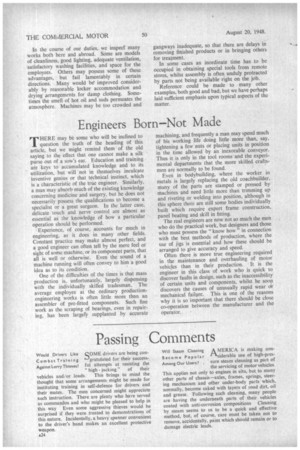American Production Methods
Page 25

Page 26

If you've noticed an error in this article please click here to report it so we can fix it.
SOME people are inclined to look upon Sir Stafford Cripps's scheme for a greater degree of consultation with the Upited States on production as being somewhat revolutionary and a direct reflection upon British manufacturers. In our view, such co-operation would have little result Upon the commercial side of the motor industry, and according to a statement made by Mr. R. Gresham Cooke, M.A., director of the Society of Motor Manufacturers and Traders, that body is not particularly interested from the angle of the private car.
In both connections, there has for some years past been a considerable interchange of views between the producers in the two countries, and quite a number of representatives of British interests has visited American factories and talked matters over with their high-ranking executNes.
The principal difference between production here and in the States is more a matter of labour conditions than methods of manufacture, combined, of course, with the fact that America has an enormous home market, whereas ours is much more limited. If, as a consequence of any talks which result, labour here can be brought to the view that the speeding up of production is of vital importance to our future and that only in this way can the workers hope to maintain or improve their wage levels, and retain a high level of employment, then something good will have been achieved.
Our Works Well Equipped Most of our commercial-vehicle, component and accessory factories are now well equipped with up-to-date machine tools, although. there may be some which could do with some more but are faced with the present difficulty of supply. Line production, which may be said to have been an idea from the States, is employed almost exclusively and, in fact, as we mentioned a little while ago, some of our works are even better equipped with machines than corresponding establishments in the U.S.A.
Apart from the mere question of labour, there is the equally vital one of the supply of essential materials—steel, cuprous alloys, light metals, tin plate, glass, seasoned timber, and those partly finished, such as castings and stampings. As in America, production in our main factories depends greatly upon numerous suppliers, and it is possible that the factories and equipment of some of these could be improved, although we do not go in quite so much for chassis and bodies built from proprietary units and components as do the Americans.
We know of at least one important commercialvehicle works which, if it could obtain full supplies, could by itself meet the equivalent of the pre-war home demand, but as a result of shortages it has to work at about 40 per cent. of its estimated capacity; even now, it is helping other concerns considerably by machining material for them.
Chassis Delayed by Bodies It is perhaps in relation to bodywork that the greatest obstacle is encountered. At many of the works catering for this need, dozens of beautifully built chassis can be seen awaiting bodies, and it might well take years to complete even present orders. Many chassis, of course, are now sent abroad to be equipped with locally built coachwork, and this is ameliorating the position, whilst other factories for this work are being opened in Britain, but it will require a long time to overtake arrears and to achieve a production which will balance that of chassis.
Works managers have told us that it now takes approximately three workers to produce what was achieved by two just before the war. Shorter working hours no doubt partly account for this, but there are also certain restrictive practices and a lack of incentive which are thorns in the side of managements.
Difficult living conditions no doubt exercise some influence. Enthusiasm and energy are not fellow travellers with lightly filled stomachs and a diet which possesses little variety. As always, it is necessary to feed the ox that treads the corn. Workers' canteens have certainly assisted, where these are properly managed and the supplies available well cooked, but in some, little initiative is expressed in the way of menus, and even good food may become monotonous if it be not made appetizing and be well served. In the course of our duties, we inspect many works both here and abroad. Some are models of cleanliness, good lighting, adequate ventilation, satisfactory washing facilities, and space for the employees. Others may possess some of these advantages, but fail lamentably in certain directions. Many would be improved considerably by reasonable locker accommodation and drying arrangements for damp clothing. Sometimes the smell of hot oil and suds permeates the atmosphere. Machines may be too crowded and gangways inadequate, so that there are delays in removing finished products or in bringing others for treatment.
In some cases an inordinate time has to be occupied in obtaining special tools from remote stores, whilst assembly is often unduly protracted by parts not being available right on the job.
Reference could be made to many other examples, both good and bad, but we have perhaps laid sufficient emphasis upon typical aspects of the matter.






















































































